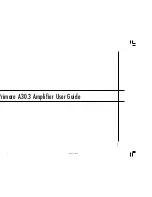
33
Operating Manual - nX, nXe, and nXp Power Amplifiers
Level
- Selected filter boost/cut amplitude.
Bandwidth
- Selected filter bandwidth (or Q). .
Filter Type Details
Parametric EQ Filters
Parametric EQ uses peak filters with the ability to control boost or cut, frequency center, and bandwidth. Think of one band of
parametric EQ as a single graphic equalizer fader, except that the frequency is variable, and that the bandwidth, or how "wide"
the filter affects the frequency spectrum at the center frequency, is also variable. The smaller the bandwidth, the less the audio
signal on either side of the frequency center is boost or cut, whereas a larger "wider" bandwidth produces an audible change to
the overall tone of a signal. Parametric filters are best used to hunt down and eliminate problem feedback frequencies, add or
remove a characteristic "hot spot" from microphones, or clean up room resonance situations. It is well worth the time becoming
proficient with parametric EQ filters, as they offer the best solution to many EQ problems.
Parametric filters have a boost/cut range of +15dB to -30dB. There is more cut than boost because one of the more common
uses for parametric filters is to dramatically cut, or "notch out", very narrow frequencies (low bandwidth) in order to eliminate
system feedback problems.
Every instance of a parametric EQ filter has a center frequency selected. The factory default is 1kHz, but each filter's center
frequency is adjustable from 20Hz to 2000Hz in 1/96 octave steps. Carefully sweeping a narrow bandwidth filter through a
problem feedback area, with just a slight boost, is a quick way to find the exact frequency causing trouble. Once the offensive
frequency has been found, cut the filter's level, and the adjust the bandwidth as narrow as possible while still eliminating the
feedback problem. Bandwidth is adjustable from about 1/64 octave to four octaves, and the lower the bandwidth, the less audible
the filter action will be. Finding the problem frequency is relatively easy, but finding the best combination of cut and bandwidth
takes a little practice. Again it is well worth the time getting comfortable with the notching procedure, so that problems can be
quickly addressed with a sufficient but minimal amount of correction.
Shelving EQ Filters
1st order filters use a gentle 6dB per octave slope, while 2nd order filters use a 12dB per octave slope for a more pronounced
boost or cut. All shelving filters have a boost/cut range of +/- 15dB. Low shelving filters have a frequency range from 20Hz
through 2kHz, the high shelving filters range from 3.886kHz through 20kHz. Shelving filters are most useful as broad tone
controls to boost or cut the high end or low end of an audio signal's frequency content. Because they affect a wider spectrum of
audio, they are not as suitable for feedback control as parametric filters.
All-Pass Filters
The all-pass option is a 2nd order all-pass filter which provides a -180 degree phase shift at the corner frequency. At very high
frequencies the phase delay approaches -360 degrees. All-pass filters may be used to add frequency dependent phase shift or
phase delay to the audio signal path. It does not produce a measurable effect on the magnitude response of the signal.
















































